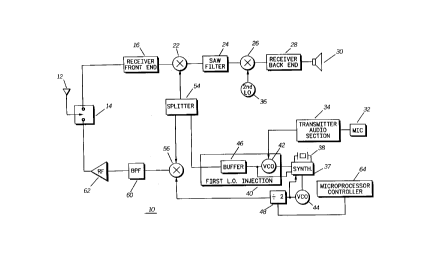Some of the information on this Web page has been provided by external sources. The Government of Canada is not responsible for the accuracy, reliability or currency of the information supplied by external sources. Users wishing to rely upon this information should consult directly with the source of the information. Content provided by external sources is not subject to official languages, privacy and accessibility requirements.
Any discrepancies in the text and image of the Claims and Abstract are due to differing posting times. Text of the Claims and Abstract are posted:
| (12) Patent: | (11) CA 2122735 |
|---|---|
| (54) English Title: | OSCILLATOR FREQUENCY DIVIDE-DOWN TRANSMIT OFFSET SCHEME FOR REDUCING SELF-QUIETING |
| (54) French Title: | METHODE DE PRODUCTION D'UNE FREQUENCE DE DECALAGE PAR DIVISION DE LA FREQUENCE D'UN OSCILLATEUR POUR MODE D'EMISSION |
| Status: | Deemed expired |
| (51) International Patent Classification (IPC): |
|
|---|---|
| (72) Inventors : |
|
| (73) Owners : |
|
| (71) Applicants : | |
| (74) Agent: | GOWLING WLG (CANADA) LLP |
| (74) Associate agent: | |
| (45) Issued: | 1998-12-22 |
| (86) PCT Filing Date: | 1992-10-30 |
| (87) Open to Public Inspection: | 1993-05-13 |
| Examination requested: | 1994-05-02 |
| Availability of licence: | N/A |
| (25) Language of filing: | English |
| Patent Cooperation Treaty (PCT): | Yes |
|---|---|
| (86) PCT Filing Number: | PCT/US1992/009304 |
| (87) International Publication Number: | WO1993/009606 |
| (85) National Entry: | 1992-10-30 |
| (30) Application Priority Data: | ||||||
|---|---|---|---|---|---|---|
|
A radio communication device (10) having a receive mode and a transmit mode, includes a receiver portion, a transmitter
portion, and multiple oscillators for providing reference waveforms for the radio communication device (10). During the receive
mode, the receiver portion receives signals having a selected frequency, converts received signals to at least a first intermediate
frequency (1F), and a transmitter oscillator (44) produces a first waveform having a frequency equal to a multiple of the first
intermediate frequency during the receive mode. During the transmit mode, the transmitter portion requires a reference waveform
having an offset frequency equivalent to the first 1F frequency to produce a radio frequency signal. Thus, the radio communication
device also comprises a divider (48) coupled to the transmitter oscillator (44) for dividing the frequency of the first waveform
to the required offset frequency in the transmit mode.
Dispositif de radiocommunication (10) comprenant un mode de réception et un mode d'émission. Le dispositif est constitué d'un récepteur, d'un émetteur et de nombreux oscillateurs qui lui (10) assurent une forme d'onde de référence. Lorsqu'il est en mode de réception, le receveur reçoit des signaux d'une fréquence choisie, convertit ces signaux en au moins une première fréquence intermédiaire (IF) et un oscillateur d'émission (44) produit une première forme d'onde dont la fréquence est égale à un multiple de la première fréquence intermédiaire au cours du mode de réception. En mode d'émission, l'émetteur nécessite une forme d'onde d'une fréquence décalée équivalent à la première fréquence IF afin de produire un signal de fréquence radio. Le dispositif de communication radio comprend également un diviseur (48) raccordé à l'oscillateur d'émission (44) afin de diviser la fréquence de la première forme d'onde en vue d'obtenir la fréquence décalée requise en mode d'émission.
Note: Claims are shown in the official language in which they were submitted.
Note: Descriptions are shown in the official language in which they were submitted.

For a clearer understanding of the status of the application/patent presented on this page, the site Disclaimer , as well as the definitions for Patent , Administrative Status , Maintenance Fee and Payment History should be consulted.
| Title | Date |
|---|---|
| Forecasted Issue Date | 1998-12-22 |
| (86) PCT Filing Date | 1992-10-30 |
| (85) National Entry | 1992-10-30 |
| (87) PCT Publication Date | 1993-05-13 |
| Examination Requested | 1994-05-02 |
| (45) Issued | 1998-12-22 |
| Deemed Expired | 2002-10-30 |
There is no abandonment history.
| Fee Type | Anniversary Year | Due Date | Amount Paid | Paid Date |
|---|---|---|---|---|
| Application Fee | $0.00 | 1992-10-30 | ||
| Maintenance Fee - Application - New Act | 2 | 1994-10-31 | $100.00 | 1994-09-26 |
| Registration of a document - section 124 | $0.00 | 1994-10-21 | ||
| Maintenance Fee - Application - New Act | 3 | 1995-10-30 | $100.00 | 1995-09-28 |
| Maintenance Fee - Application - New Act | 4 | 1996-10-30 | $100.00 | 1996-09-24 |
| Maintenance Fee - Application - New Act | 5 | 1997-10-30 | $150.00 | 1997-09-19 |
| Final Fee | $300.00 | 1998-08-07 | ||
| Maintenance Fee - Application - New Act | 6 | 1998-10-30 | $150.00 | 1998-09-22 |
| Maintenance Fee - Patent - New Act | 7 | 1999-11-01 | $150.00 | 1999-09-16 |
| Maintenance Fee - Patent - New Act | 8 | 2000-10-30 | $150.00 | 2000-09-20 |
Note: Records showing the ownership history in alphabetical order.
| Current Owners on Record |
|---|
| MOTOROLA, INC. |
| Past Owners on Record |
|---|
| BORRAS, JAIME A. |
| MARKO, PAUL D. |